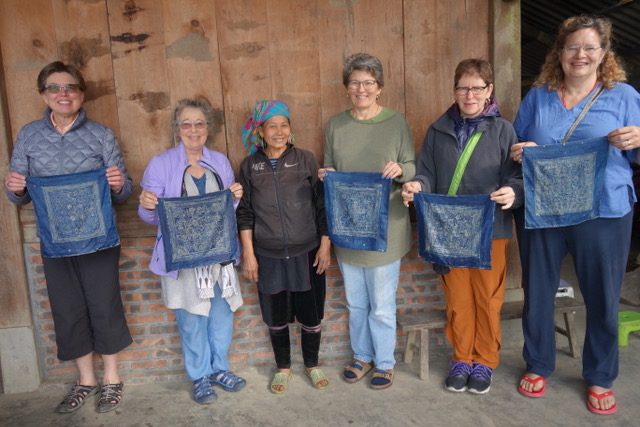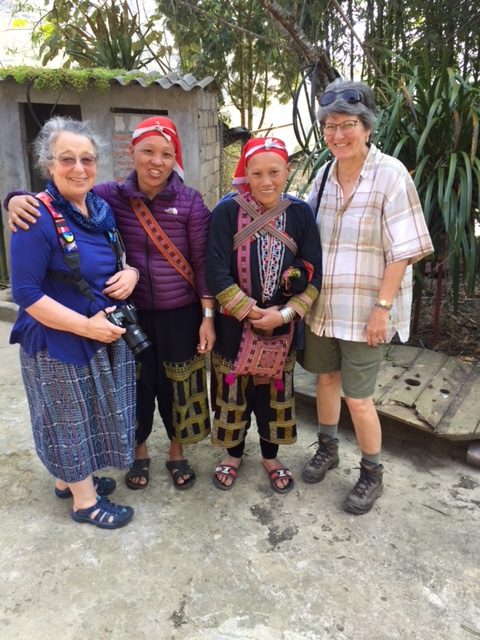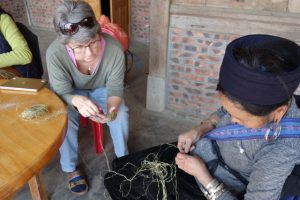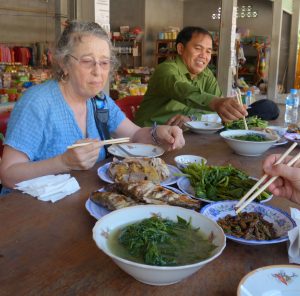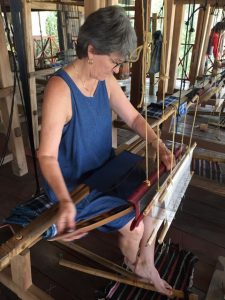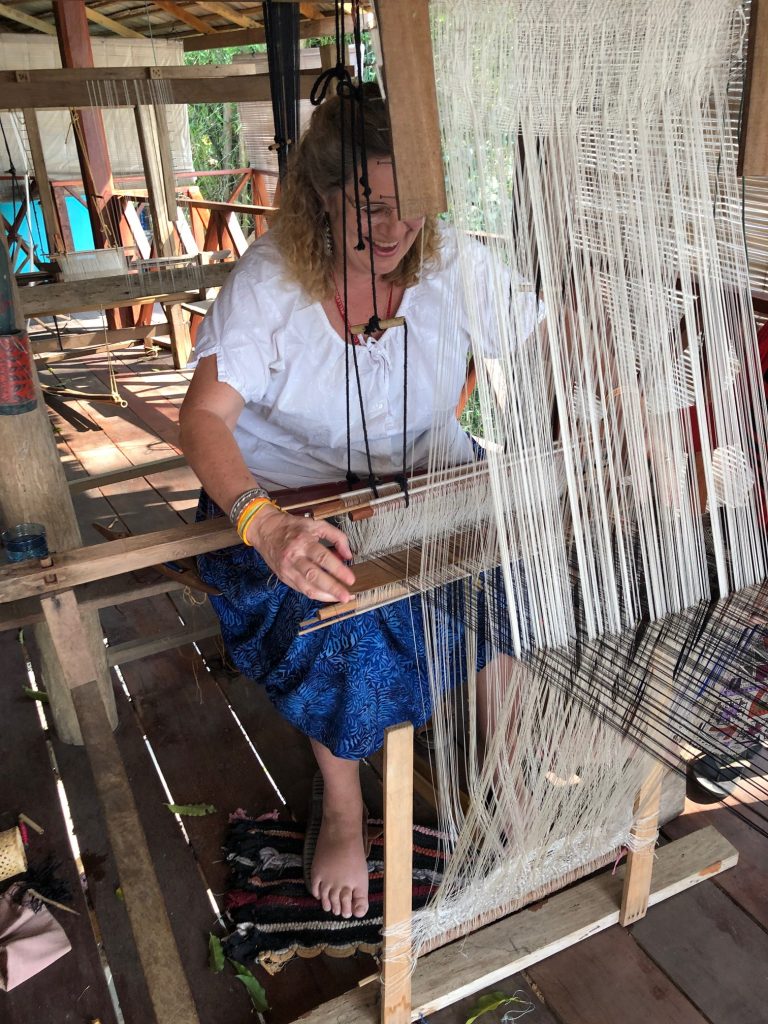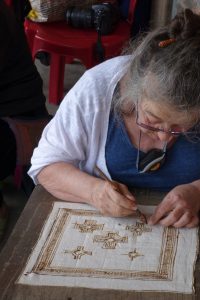
A guest focuses on creating her own wax-resistant batik pattern in a workshop taught by a Black Hmong woman.
It was the fourth day of the tour, and, having whirl-winded through Hanoi old town and museums, taken a night train, and then survived the bustle of the Bac Ha market, we were each perched on a stool with a slightly waxed board on our laps, a piece of hemp carefully smoothed over its surface, and, following our teacher Tshai’s directions, we each dipped our handmade batik tool into the hot wax in an iron pot over coals, and attempted to draw the traditional Hmong designs on our cloth. Much hilarity, unintended drops of wax, wiggly lines, and not enough space for the designs later, we each finished our own sample piece. Next, into our hostess Thi’s indigo pot for the deep, beautiful blue. Multiple dippings and dryings later, the pieces were boiled to take off the wax and reveal the designs. They were good! We were each so thrilled with our first attempts at Hmong batik.
Batik was our first of many workshops in local textile arts in both Vietnam and Laos. Thi also instructed us in how to peel, soften, and splice hemp fiber, the first three steps of a very lengthy process to create the hemp cloth used in making Hmong clothing. Two different embroidery classes followed – Black Hmong embroidery, and then Red Dzao. We also wandered through villages, trying out the hemp looms, seeing other indigo dye pots, looking for weaving tools, “ironing” hemp between a rock and a log, and visiting the local shops and markets to purchase handmade textile items. We even had a traditional Dzao/Yao herbal “sauna” bath at our last homestay night!
Meanwhile, the food was delicious, local, and cooked by the families with whom we stayed. Spring rolls were delicious! We also had fresh steamed vegetables, chicken, pork, steamed rice, pancakes with mangos or bananas, fried rice, bamboo shoots, and tomatoes with tofu. Delicious! Always plenty to eat, and special “happy water” (rice whiskey) for a couple evenings too.
A few travel days later, reeling silkworms was on the agenda. Mai Souk, our silk reeling teacher, showed us the process for raising and reeling silk, and, much to the amusement of the remainder of the onlooking villagers, we each had turns at learning the feel of reeling and winding skeins of silk.
Two days of natural dyeing followed, with natural dye experts Souk and Phout at the lead. We made fresh indigo green, red from lac, light and medium gold from Dton Ven (the bark of a huge jungle tree), among others, giving us 6 skeins of silk and one handwoven (by Phout) silk scarf dyed in the color of our choice. Phout, the renown faster fringe twister of the region taught us her method, and the weavers of Xam Tai came around frequently to share their beautiful textiles for us to admire and buy. A day of wandering around local villages, seeing their looms and tools, and getting a feel for the countryside was followed by the special, ubiquitous Laos ritual of a basi, given in our honor.
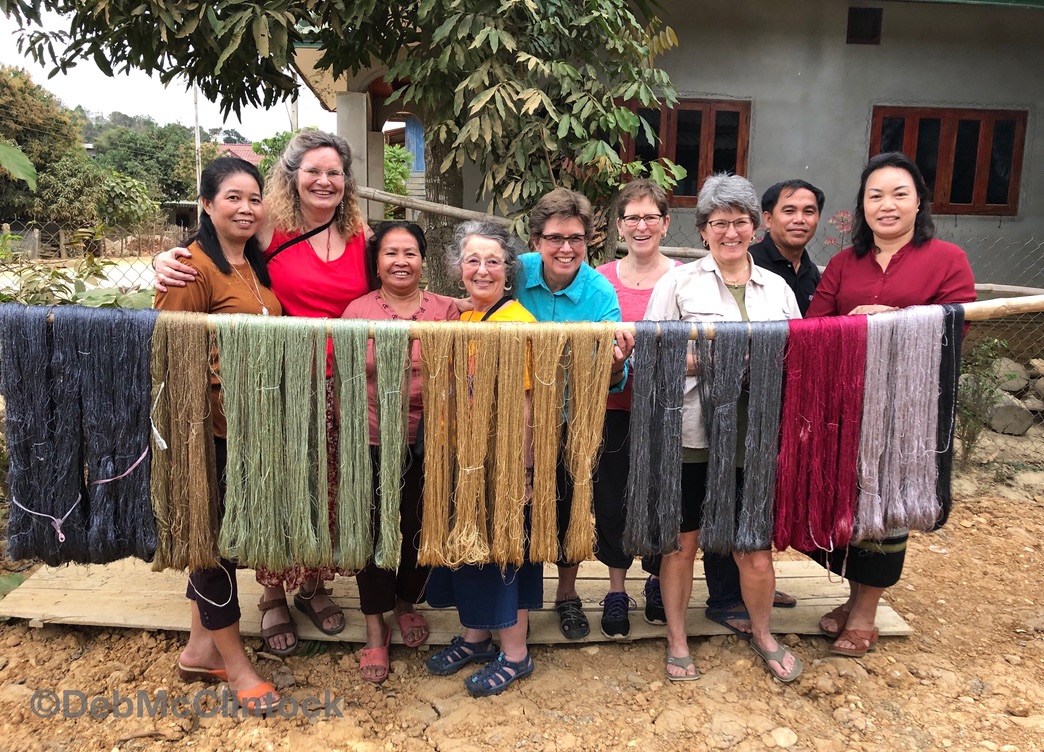
The crew with our skeins of hand-reeled silk we had just naturally-dyed with locally harvested materials. Souk (far left), Lun (third from left), and Phout (far right) are master dyers in Xam Tai.
Again, delicious, local food abounded. Every meal had at least two types of cooked greens, and often fresh greens too. Boiled chicken, fried fish, fish soup, ant eggs, chicken eggs, silkworm larvae, bamboo shoots, more greens, fresh pork, fried pork belly, bananas of all sorts, pineapple, watermelon, instant coffee, beer, lao-lao, and more appeared throughout our freshly cooked home meals.
Enroute to Xam Neua, we stopped in a basket weaving village to observe the community members gathering to weave the double-walled sticky rice baskets from which we ate at every meal in Laos. We also toured the caves in Vieng Xai, the headquarters of the Pathet Lao during the American/Vietnam war, a fascinating view into the struggle to establish the current Lao government. In Xam Neua, we visited the market admiring textiles, weaving tools, and a myriad of fruits and vegetables before settling down for the night in a local guest house.
Next day, we got an early start to the town of Na Sala, where we learned from Lao Loum friend Thong how to gin, bow fluff, roll punis, spin, wind skeins, and wind the village-raised cotton on the matmi (ikat) frame in order to tie our own matmi scarf! We took the frames with us to finish tying the pattern during our trip. Some people even dyed their cotton at our weaving day at Ock Pop Tok.
A day and a half were spent in Phonsavanh, Xieng Khuong Province, visiting the new museum (nice!), Mulberries silk farm, the Mines Advisory Group center, a Tai Dam village, the village of Napia where they smelt the aluminum from the bombs America dropped on Lao during the Vietnam war to make spoons and bracelets and other saleable items, plus a tour of one of the Plain of Jars sites.
Finally, we made it to Luang Prabang, where we wrapped up all of our silk experiences by weaving our very own textile on a traditional Lao floor loom with a pattern using both continuous and discontinuous supplemental weft patterning – just like all of the stunning textiles we viewed (and purchased!) in Xam Tai – though a touch simpler! We also had a personal tour of the Traditional Arts and Ethnology Center in Luang Prabang, toured a temple, gave morning alms to the monks, and ended at the beautiful Kuang Si waterfall where we swam and assisted with making a Lao meal for our dinner.
It was an incredibly varied, and busy, tour with opportunities to see and actually do the textile arts of each of the cultures of the people with whom we stayed. Staying and learning with these artists friends is an opportunity only possible through our tours.
Want to join us on our next tour? Write to me at maren@HilltribeArt.com or call me at 541-686-4285. We’d love to share our friends and the beauty of Vietnam and Lao with you!

